21.12.2006
K.Sakaev. Creativity at the Superfinal, Rounds 6-8
Round 6
I.Nepomniachtchi (2545) – D.Jakovenko (2671) [C77]
Round 6 wasn`t the most combative therefore this game, not too impressive on the whole turned out to be the pithiest of all.
1.e4 e5 2.¤f3 ¤c6 3.Ґb5 a6 4.Ґa4 ¤f6 5.Јe2. A rare move which aims at diverting the game from the trodden theoretical paths.
5...b5 6.Ґb3 Ґe7 7.c3 0–0 8.d3. To 8.0–0 Black has a good reply 8...d5, forcing d2-d3 anyhow, while to 8.d4 the recent theory considers 8...exd4 9.e5 ¦e8! as a good continuation.
8...¦e8. Commonly Black plays 8...d6, with a good position as well. 8...d5 is associated with a pawn sac – 9.exd5 ¤xd5 10.¤xe5, therefore Dmitry prepares this advance without lengthy manoeuvres and the insertion of d7-d6 as he wants to realize it in one move.
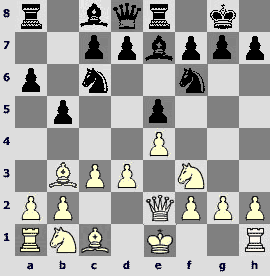
9.Ґg5. This move is again aimed against d7-d5, but the early entrance of the dark-squared bishop in these structures is always welcome by Black who benefits from its exchange.
The following continuation could lead to a complex unexplored fight at an early stage already – 9.¤g5 ¦f8 (bad is 9...d5? on account of motives known to all children who study chess – 10.exd5 ¤xd5 11.¤xf7 ўxf7 12.Јf3+ ўe6 13.c4 with a strong attack) 10.0–0 (10.¤f3 leads to repetition) 10...¤a5 11.Ґc2 – the bishop should be saved from being traded – 11...d5, and now both 12.d4 and 12.f4!? deserve consideration.
Not good is 11.Ґxf7+ ¦xf7 12.¤xf7 ўxf7 13.f4 d6 – Black has an extra material while White has got no special initiative.
11.f4 ¤xb3 12.axb3 exf4! 13.Ґxf4 [13.e5 doesn`t work – 13... ¤d5 14.¤xh7 (14.Јe4 Ґxg5 15.Јxd5 ¦b8 16.Ґxf4 Ґxf4 17.¦xf4 Ґb7 18.Јd4 Јg5 favours Black as well) 14...¦e8, and the knight is stuck on h7] 13...d5 14.e5 Ґg4!, followed by ¤f6-h5 isn`t dangerous for Black either. ;
9...d6 10.¤bd2 h6 11.Ґh4 ¤a5 12.Ґc2 c5 13.¤f1. To 13.0–0 Black would also have a good reply 13...¤h5.
13...¤h5 14.Ґg3. It`s difficult to bring himself to play 14.Ґxe7, but it was also quite possible: 14...Јxe7 15.¤e3 (15.g3 Ґh3 16.¤e3 ¤f6 17.¤g1 Ґe6 18.¤f3 is not that safe as Black can risk a bit: 18...d5!? 19.¤xe5 d4, with excellent compensation for a pawn) 15...¤f4 16.Јd1 Ґe6 17.0–0 followed by g2-g3 with equality.
14...Ґe6 15.¤e3 Ґf6 16.0–0 g6. Black`s regrouping is simple and natural.
17.a3 ¤c6 18.Јd1 ¤e7

19.d4?! After this move the dark-squared conflict begins to which White isn`t ready as his bishop on g3 is attacked. Correct is the natural 19.Ґb3, maintaining an approximate equality. Now in case of 19...¤xg3 White has a good resource 20.fxg3!, opening the f-file when he is not afraid of 20...c4 21.dxc4 Јb6 22.Јe2 bxc4 23.Ґa2 d5 24.ўh1 with excellent play along the light squares.
19...¤xg3 20.hxg3 exd4 21.cxd4 Ґg7. The King`s Indian bishop feels fine, Black is slightly better.
22.Јd2. 22.d5 is anti-positional, as White is unable to realize e4-e5 whereas another active possibilities don`t exist. Black plays 22...Ґd7 23.¦b1 ¤c8!, then he puts the knight on b6 and develops the queenside initiative by a6-a5, b5-b4 etc.
22...d5 23.¦ad1 ¦c8. 23...c4!? deserved attention leaving White with the pile of pieces on the d-file. The kingside attack fails: 24.e5 ¤c6 25.¤h2 f5!, anticipating f2-f4-f5. Now if 26.f4 h5! and everything is blocked but Black retains the pawn majority on the queenside and soon these pawns will start moving.
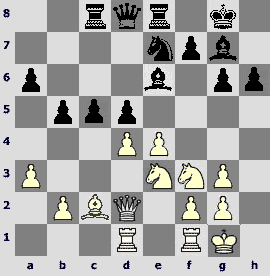
24.e5. Not good is 24.exd5 ¤xd5 25.dxc5 ¤xe3 26.Јxe3 Јf6! (this is a better version of winning the exchange than 26...Јc7 27.b4 Ґc4 28.Јf4 Ґxf1 29.ўxf1) 27.b4 Ґc4 28.Јf4 Јc3 29.Ґe4 Ґxf1 30.¦xf1 ¦e7 with excellent winning chances. It seems that equality could be maintained by 24.dxc5! dxe4 25.¤d4 Јd7 (other ways are not dangerous: 25...Јxd4 26.Јxd4 Ґxd4 27.¦xd4 ¦xc5 28.Ґxe4, or 25...¦xc5 26.Јb4, or 25...Ґc4 26.¤xc4 bxc4 27.Ґa4 ¦f8 28.b4 cxb3 29.¤xb3 Јxd2 30.¦xd2, and it is only Black who takes the risk) 26.Ґxe4! (inferior is 26.¤xe6 Јxe6 27.b4 ¤c6! – the knight rushes towards d4, and Black obtains an edge). Now to 26...¦ed8 (if 26...¦xc5 then 27.Јb4 solves the problems), White has 27.¤ec2 ¤f5 (if Black provokes f2-f3 first, then after 27...Ґg4 28.f3 ¤f5 White gets an unexpected tactical resource 29.Јf2 ¤xd4 30.c6!) 28.Ґxf5 Ґxf5 29.Јc1. White`s pieces are placed passively but he retains the extra pawn.
24...¤c6! It was possible to win a pawn: 24...cxd4 25.¤xd4 Ґxe5 26.¤xe6 fxe6 27.¤g4 Ґg7, and White`s compensation is clearly insufficient. The text is stronger from the standpoint of a player as Black doesn`t weaken his king and White is doomed to a passive defence.
25.¦fe1. Even worse is 25.dxc5 d4 26.Јe2 Јc7 27.¤xd4 ¤xd4 28.¦xd4 Јxe5, and the position is simplified under the circumstances highly unfavourable for White.
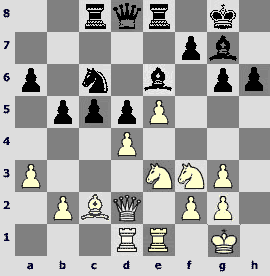
25...Јc7? But here it was very good to take the pawn – 25...cxd4 26.¤xd4 ¤xd4 (26...¤xe5 27.¤xe6 fxe6 28.f4 ¤c4 29.¤xc4 bxc4 30.Ґxg6 ¦e7 preserves the advantage nevertheless it`s not that convincing) 27.Јxd4 Јg5 28.f4 Јxg3. White has no compensation at all because his dark squares are extremely weak while to carry out f4-f5 is impossible.
26.dxc5 d4. 26...¤xe5 led to a draw after 27.¤xe5 Ґxe5 28.¤xd5 (the position is not that clear after 28.b4!? d4 29.¤f1 either; later on the bishop will stand on d3 while the knight will come to f3 via h2; however in this complex position Black`s chances are preferable) 28...Ґxd5 29.Јxd5 Јxc5 30.Јxc5 ¦xc5 31.Ґb3.
27.¤f1. Either White doesn`t see simple tactics or he is playing for a win. 27.¤xd4 ¤xd4 28.Јxd4 Ґxe5 29.¤d5, led to a simple draw transposing into the line analyzed in the previous note.
27...¤xe5 28.¤xe5 Јxc5. A questionable decision. Black eliminates his opponent`s passed pawn at the cost of a serious weakening of his own king. I would rather prefer to play the position after 28...Ґxe5 29.b4 (it could arise with another move order after 26...¤xe5, as we`ve seen above). It`s important that in this position the pawns a3, b4 and c5 are on the dark squares and in the far future could become the targets. The position is complicated but as I`ve already told Black`s chances are higher.
29.¦c1. 29.Ґxg6 Ґxe5 30.¦c1 simply leads to a transposition.
29...Ґxe5 30.Ґxg6 Јd6 31.¦xc8 [31.Ґd3 seems to be of equal value] 31...Ґxc8. Here is another line that also leads to equality: 31...¦xc8 32.Јxh6 (32.Ґd3 Ґg7 33.¤h2 is possible too) 32...fxg6 33.Јxg6+ ўf8 34.Јh6+ ўe7 35.f4 ¦h8 36.fxe5 ¦xh6 37.exd6+ ўxd6 38.¤d2.
32.Ґd3 Ґd7 33.¦e4?! The knight on f1 doesn`t have a single move so White can`t even think of 33.¤h2, with a probable continuation 33...Ґg7 34.¦xe8+ Ґxe8 35.¤f3. The black king is weak, White`s counterplay is enough for equality.
33...Ґg7?! Correct is 33...Ґc6, not being scared by ghosts. The rook will not help White to create an attack so there`s no point in transferring it to the kingside. But White could change his mind taking the rook back – 34.¦e1, finally intending the knight transference to f3 via h2.

34.¦f4? A blunder caused by the completely wrong evaluation. Theyoungmaniseagertocheckmate! It is praiseworthy but in the given situation it was better to take care of himself moreover he has an opportunity to finish the game right off – 34.¦xe8+ Ґxe8 35.¤e3 Ґd7 36.¤f5 and the draw is near.
34...Ґc6 35.¤h2 Јe6 36.Јc2?! Now the knight will be chased back to f1. Correct is 36.¤f3 Ґxf3 37.¦xf3 Јe1+ 38.Јxe1 ¦xe1+ 39.ўh2, still retaining good drawing chances.
36...Јe1+ 37.¤f1 Ґd5 38.Јc5?! Yet another blank shot. I already feel uncomfortable to attach so many question marks to the moves of such a gifted player. 38.a4!? was worthy of consideration weakening the light squares in Black`s camp and taking the pawn away from the vulnerable dark square.
38...Јe6 39.¦f5. White is already in troubles. If he returns to the defence of the key square d3 by 39.Јc2, then after 39...Јc6! 40.Јxc6 Ґxc6 41.¦f5 Ґe4 42.Ґxe4 ¦xe4 the black rook unavoidably penetrates to e2 paralyzing the whole white army.
39...Ґc4 40.¦f3 Ґxd3 41.¦xd3 Јc4 42.Јf5 ¦e1 [42...¦e5 43.Јf3 ¦e1 won simpler] 43.f4 Јc2 44.g4
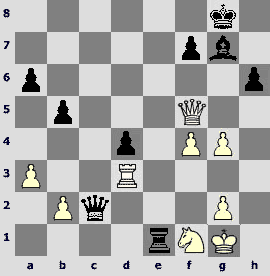
44...¦e2. Dmitry sees the winning ending and don`t even consider middle-game possibilities. The true professionalism! 44...Јe2 45.¦f3 d3! won on the spot
45.¦g3 Јxf5 46.gxf5 ўf8 47.¦d3 ¦xb2 48.¤d2 ўe7 49.g4 ўd6 50.ўf2 ўd5 51.g5 hxg5 52.fxg5 f6 53.g6 ўe5 54.ўe2 ўxf5 55.ўd1 ¦a2 56.ўc1 b4 57.axb4 ўxg6 58.¤f3 f5 59.ўb1 ¦f2 60.ўc1 f4 61.ўd1 ўf5 62.¦a3 ўg4 63.¤e1 f3 64.¤d3 ¦f1+ 65.ўd2 Ґh6+ 66.ўc2 f2 67.¦xa6 ¦c1+ 68.¤xc1 Ґxc1 69.¦a1 f1Ј 70.¦xc1 Јc4+ 71.ўd2 Јxb4+ 72.ўd3 Јa3+ 0–1
E.Alekseev (2639) – P.Svidler (2750) [C89]
Evgeny Alekseev was acting as a real pragmatic. There are opponents weaker than Peter Svidler – so they are the ones he will try to beat, even with the black pieces. Everything that was seen in this game had already been known.
1.e4 e5 2.¤f3 ¤c6 3.Ґb5 a6 4.Ґa4 ¤f6 5.0–0 Ґe7 6.¦e1 b5 7.Ґb3 0–0 8.c3 d5 9.exd5 ¤xd5 10.¤xe5 ¤xe5 11.¦xe5 c6 12.d3 Ґd6 13.¦e1 Ґf5 14.Јf3 Јh4 15.g3 Јh3 16.¤d2 ¦ae8 17.¤e4 Ґg4 18.Јg2 Јxg2+ 19.ўxg2 f5 20.Ґf4 Ґxf4 21.gxf4 fxe4 22.dxe4 Ґf3+ 23.ўxf3 ¦xf4+ 24.ўg3 ¦fxe4 25.¦xe4 ¦xe4 26.f3 ¦e5 27.c4 bxc4 28.Ґxc4 a5 29.¦d1 Ѕ–Ѕ
S.Grigoriants (2582) – E.Inarkiev (2628) [C88]
1.e4 e5 2.¤f3 ¤c6 3.Ґb5 a6 4.Ґa4 ¤f6 5.0–0 Ґe7 6.¦e1 b5 7.Ґb3 0–0 8.h3 Ґb7 9.d3 d6 10.a3 ¤a5 11.Ґa2 c5 12.¤bd2 ¤c6 13.¤f1 Ѕ–Ѕ
I.Khairullin (2543) – N.Vitiugov (2596) [B30]
1.e4 c5 2.¤f3 e6 3.¤c3 ¤c6 4.Ґb5 ¤d4 5.0–0 a6 6.Ґd3 ¤xf3+ 7.Јxf3 Јc7 8.¦e1 Ґd6 9.g3 ¤e7 10.Ґf1 Ґe5 11.¤e2 0–0 Ѕ–Ѕ
E.Tomashevsky (2595) – D.Khismatullin (2583) [A34]
White played passively and pretentiously in the opening and Black obtained excellent compensation for the sacrificed pawn. Denis Khismatullin`s hesitation on move 19 allowed Evgeny Tomashevsky to carry out massive pawn exchanges and thus to slip away with a draw.
1.¤f3 ¤f6 2.c4 c5 3.¤c3 ¤c6 4.g3 d5 5.cxd5 ¤xd5 6.Ґg2 ¤c7 7.0–0 e5 8.¤e1

Very interesting but barely good as the e1 square isn`t the optimal for the knight. Undoubtedly Evgeny Tomashevsky understands it but he has a wish to behave outrageously.
8...Ґd6 9.Ґxc6+!? This idea is well-known. In this position its main drawback is the knight on e1.
9...bxc6 10.Јa4 0–0 11.b3 Ґh3 12.¤g2 ¤e6 13.Ґa3 ¤d4 14.¦ad1 Јe7 15.f3 f5 16.e3 ¤b5 17.¤xb5 cxb5 18.Јxb5 f4!
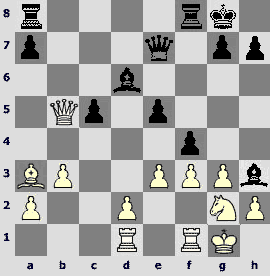
19.¦f2 ўh8?! This move may turn out to be useless in particular the white bishop`s influence along the main diagonal shouldn`t be ruled out. Meanwhile the queen`s check isn`t frightful as Black can always cover with the bishop winning a tempo. More vigorous is 19...¦ab8, driving the white queen away to a less active position.
20.gxf4 exf4 21.e4 ¦f6 22.d4 ¦b8 23.Јa5 Ґxg2
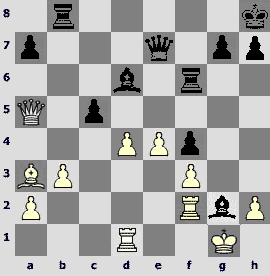
24.¦xg2. Nothing is changed after 24.e5 Ґxf3 25.¦xf3 (25.exf6? gxf6 26.¦xf3 Јe2) 25...Јb7 26.¦df1 ¦g6+ 27.ўh1 Ґe7 28.Ґxc5 Ґxc5 29.dxc5 (29.Јxc5 ¦c8 30.Јa3 Јe4) 29...Јd5 30.Јc3 ¦e8 31.Јc4 Јxc4 32.bxc4 ¦xe5 33.¦xf4 h6 with a draw.
24...cxd4 25.Ґxd6 ¦xd6 26.Јg5 Јf7 27.Јe5 ¦bd8 28.¦d3 ¦e6 29.Јc5 Јd7 30.Јg5 ¦f8 31.Јc5 ¦d8 Ѕ–Ѕ
E.Najer (2648) – S.Rublevsky (2688) [B46]
This short duel is of an opening interest solely. Sergey Rublevsky introduced a good novelty that "closes" one branch of the Paulsen Variation.
1.e4 c5 2.¤f3 e6 3.d4 cxd4 4.¤xd4 ¤c6 5.¤c3 a6 6.f4 ¤xd4 7.Јxd4 b5 8.Ґe3 Ґb7 9.Ґe2 ¦c8 10.a3 ¤f6 11.Ґf3 ¦c4 12.Јd3 Јc7 13.0–0

13...Ґc5. A novelty which simplifies the game and probably leads straight to a draw. After 13...d6 a complex position arises.
14.Ґxc5. Completely harmless. A bit stronger is 14.e5 ¤d5 15.¤xd5 Ґxd5 16.Ґxd5 exd5 17.c3, which requires precise play on Black`s part. The best is 17...0–0! [less precise is 17...d6 in view of 18.¦ae1! ¦e4 (18...0–0 19.Јxd5) 19.ўh1, and Black is in troubles for example 19...¦xe3 20.¦xe3 Ґxe3 21.Јxe3 0–0 22.e6] 18.¦ae1 [18.¦ad1 d6 (18...¦e4?! 19.Ґxc5 Јxc5+ 20.ўh1 f6 21.exf6 ¦xf6 22.Јxd5+ Јxd5 23.¦xd5 ¦fxf4 24.ўg1) 19.Ґxc5 Јxc5+ 20.ўh1 dxe5 21.fxe5 ¦e4 22.Јxd5 ¦xe5 23.Јxc5 ¦xc5 24.¦d6 a5, with a draw] 18...¦e4!? (also possible is 18...Ґxe3+ 19.¦xe3 Јb6 20.ўh1 d4 21.¦h3 h6 and White`s advantage is just symbolical) 19.ўh1 Ґxe3 20.¦xe3 Јc4 21.Јxc4 bxc4 22.¦xe4 dxe4 where both sides have the weaknesses and the game should end in a draw.
14...Јxc5+ 15.ўh1 0–0 16.e5 Ґxf3 17.Јxf3 ¤d5 18.¤xd5 Јxd5 19.c3 [or 19.Јxd5 exd5 20.c3 f6 21.exf6 ¦xf6 22.g3 d4] 19...f6 20.Јxd5 exd5 21.¦ad1 fxe5 22.¦xd5 exf4 23.¦xd7 ¦e4 24.ўg1 ¦e2 25.¦f2 ¦e1+ 26.¦f1 ¦e2 27.¦f2 Ѕ–Ѕ
7 тур
D.Jakovenko (2671) – I.Khairullin (2543) [B90]
Well it was Beckham`s bad day... Dmitry Jakovenko blundered two times so zero in the cross-table is fully deserved.
1.e4 c5 2.¤f3 d6 3.d4 cxd4 4.¤xd4 ¤f6 5.¤c3 a6 6.Ґe3 e5 7.¤f3 Ґe7 8.Ґc4 0–0 9.0–0 ¤c6 10.¦e1 b5 11.Ґb3 ¦b8
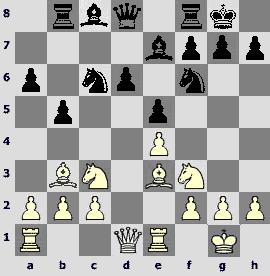
12.Ґg5?! The exchange of the dark-squared bishops is in Black`s favour. 12...¤d7 13.Ґxe7 Јxe7 14.¤d5 Јd8 15.c3 ¤c5 16.Ґc2 a5 17.b4 axb4 18.cxb4 ¤e6 19.Ґb3 ¤ed4 20.¤xd4 ¤xd4 21.¤e3 Ґe6 22.Ґd5 ¦c8 23.a4 bxa4 24.Јxa4 Јg5 25.¦f1 ¦b8 26.ўh1 Јh4 27.¦ae1 ¦fc8 28.¦b1 h6 29.b5 Ґd7 30.Јa7 Ґxb5

31.¤f5? [31.Јxf7+ ўh7 32.Јa7 maintained the balance] 31...¤xf5 32.exf5 Јf6 33.¦b3 ¦a8. Even stronger is 33...Јxf5! 34.¦fb1 e4 35.Јd4 e3 36.fxe3 Ґe8 with good winning chances for Black.
34.Јxf7+ Јxf7 35.¦xb5 ¦a2 36.Ґxf7+ ўxf7
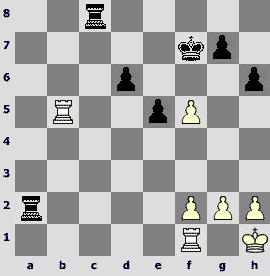
37.¦d5?? [37.g4 still offered good drawing chances.] 37...¦xf2 38.ўg1 ¦xf1+ 39.ўxf1 ўe7 40.ўe2 ¦c5 0–1
S.Rublevsky (2688) – S.Grigoriants (2582) [C45]
For the second time in the championship Sergey Rublevsky is trying to win the Scotch ending and again in vain. Is it his poor form in this competition to blame or White just has no real advantage in this position – I`m unable to understand.
1.e4 e5 2.¤f3 ¤c6 3.d4 exd4 4.¤xd4 Ґc5 5.¤xc6 Јf6 6.Јf3 bxc6 7.¤d2 a5 8.Ґd3 d6 9.Јg3 ¤e7 10.0–0 h5 11.¤c4 h4 12.Јf4 Јxf4 13.Ґxf4 Ґe6 14.Ґd2 a4 15.b4 Ґd4 16.c3 Ґa7 17.a3 ¤g6 18.¦fe1 f6 19.Ґe3 Ґxc4 20.Ґxc4 ¤e5 21.Ґa2 g5 22.Ґxa7 ¦xa7 23.¦f1 h3 24.f4 hxg2 25.ўxg2 gxf4 26.¦xf4 ўe7 27.¦h1 ¦aa8 28.h4 ¦h7 29.h5 ¦g7+ 30.ўf1 ¦g3 31.¦g1 ¦xg1+ 32.ўxg1 ¦h8 33.¦f5 ¤g4 34.¦f4 ¤e5 35.¦f5 ¤g4 36.¦f4 Ѕ–Ѕ
D.Khismatullin (2583) – E.Alekseev (2639) [E20]
Sometimes strange metamorphoses occur over the board! Both opponents were unfamiliar with the theory of a rather rare branch of the Nimzo-Indian Defence. Seeing the position after Black`s 9th move nobody would be surprised had he lost it around move 15. But the things turned the way that White could have resigned already on move 11. Such is the case!
1.d4 ¤f6 2.c4 e6 3.¤c3 Ґb4 4.g3 c5 5.¤f3 cxd4 6.¤xd4 Јc7 7.Јb3 Ґc5 8.Ґf4 d6 9.¤db5 Јc6
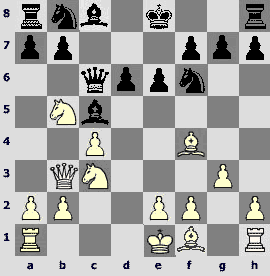
10.0–0–0? Denis decided to play in a Morphy`s style but Zhenya Alekseev is a high class grandmaster and even Morphy would have had problems being a rook down against him. Very strong was 10.¦g1 e5 11.Ґg2 [White also has an advantage after 11.Ґg5 ¤bd7 (totally bad is 11...¤g4 12.0–0–0 ¤xf2 13.Ґg2) 12.Ґg2 Јb6 13.0–0–0 0–0, and here he has different good moves, one of them is 14.¤xd6, transposing into a better ending] 11...Ґxf2+ (White has a crushing attack after 11...Јb6 12.0–0–0) 12.ўxf2 Јc5+ 13.Ґe3 ¤g4+ 14.ўe1 ¤xe3 15.¤e4 ¤c2+ (no better is 15...¤xg2+ 16.¦xg2 Јc6 17.¤bxd6+) 16.ўd2 ¤xa1 17.¦xa1 Јb6 18.¤exd6+ ўe7 19.Јa3 ¦d8 20.ўc2 ¦xd6 21.¦d1 winning.
10...Јxh1 11.Ґxd6?! [11.¤c7+ would keep some tension although the knight wouldn`t feel fine on a8] 11...¤a6. That`s it, White may resign.
12.Ґxc5 ¤xc5 13.¤c7+ ўe7 14.Јa3 b6 15.b4 ¤cd7 16.b5+ ўd8 17.Ґh3 Јxd1+ 18.ўxd1 ўxc7 19.Јe7 ¦f8 20.e4 ¤g8 21.Јg5 Ґb7 22.Јxg7 ¦ad8 23.ўc2 ўb8 24.f3 ¤c5 25.Ґf1 f5 26.exf5 exf5 27.¤d5 Ґxd5 28.cxd5 ¤f6 29.Ґc4 ¤b7 30.Јh6 ¤d6 31.ўb3 ¦f7 32.Јh4 ¤xc4 33.Јxc4 ¤xd5 34.Јd3 f4 35.gxf4 ¦xf4 36.a3 ¦f7 37.h4 ¦dd7 38.h5 ¤c7 39.Јe4 ¤xb5 0–1
N.Vitiugov (2596) – E.Najer (2648) [D43]
In the Moscow Variation of the Slav Defence White was maintaining a slight pressure but on move 22 the opponents exchanged compliments. White dropped a piece while Black didn`t notice it. The rest is of little interest, it was a normal positional game.
1.d4 d5 2.c4 c6 3.¤c3 ¤f6 4.¤f3 e6 5.Ґg5 h6 6.Ґxf6 Јxf6 7.e3 ¤d7 8.Ґd3 dxc4 9.Ґxc4 g6 10.0–0 Ґg7 11.b4 0–0 12.¦c1 e5 13.Ґb3 exd4 14.¤xd4 ¤b6 15.a4 Јe7 16.a5 ¤d7 17.b5 ¤e5 18.bxc6 ¤xc6 19.¤d5 Јa3 20.¤xc6 bxc6 21.¦xc6 ¦b8
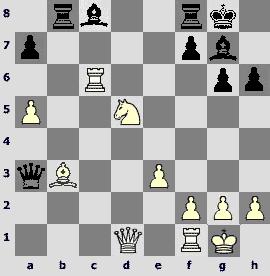
22.Јc1??
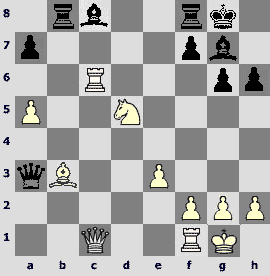
22...Ґb2?? Black could win by 22...Јxb3 23.¤e7+ ўh7 24.¤xc8 (or 24.¦xc8 ¦bxc8 25.¤xc8 Јb8 26.¤e7 Јd6 27.¤c8 Јd7) 24...Ґb2 25.Јc5 Ґa3 26.Јc3 Јxc3 27.¦xc3 Ґb4.
23.Јc2 Ґf5 24.e4 Ґxe4 25.Јxe4 Јxb3
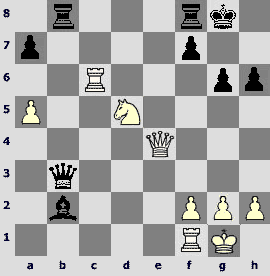
26.¦c7? [26.¤e7+ ўh8 27.¦c7 allowed to take the a7 pawn and to keep winning chances] 26...¦fe8 27.¤e7+ ўg7 28.Јg4 Јd3 29.¤c6 ¦b5 30.¦d7 Јf5 31.Јxf5 ¦xf5 32.¦xa7 ¦e6 33.¦b7 ¦xc6 34.¦xb2 ¦xa5 Ѕ–Ѕ
E.Inarkiev (2628) – E.Tomashevsky (2595) [E15]
After coming across an opening surprise already on move 5 Evgeny Tomashevsky decided to reply adequately but finally found himself in a clearly inferior position. Ernesto Inarkiev realized a nice positional pawn sacrifice (25.e5!), and on the whole he was conducting a good positional game but committed a serious inaccuracy on move 48 allowing Evgeny to break free. Becoming upset he made some more mistakes and lost.
1.d4 ¤f6 2.c4 e6 3.¤f3 b6 4.g3 Ґa6 5.Јc2. The efforts of Aronian and Mamedyarov have made this move popular but apparently not for long.
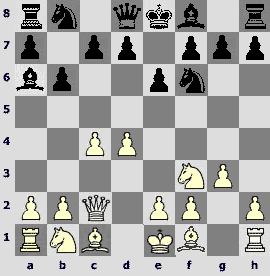
5...b5?! In response to 5.b3 this undermining is not that bad but here it is clearly feeble.
6.cxb5 Ґxb5 7.Ґg2 Ґb4+ 8.¤c3 0–0 9.0–0 Ґc6 10.¦e1 Ґxc3 11.Јxc3 Јc8 12.Ґh3 d6 13.¤d2 Јb7 14.¤c4 Ґd5 15.f3 Ґxc4 16.Јxc4 ¤bd7 17.b4 a5 18.b5 a4 19.Ґd2 ¤b6 20.Јd3 d5 21.¦ab1 ¤c4 22.¦ec1 ¤e8 23.Ґb4 ¤ed6 24.e4 ¦fd8
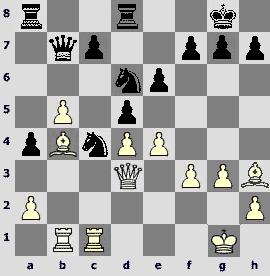
25.e5! ¤xb5 26.f4 c6 27.Ґc5 ¦db8 28.f5 Јd7 29.¦f1 ¤c7 30.f6 ¤a6 31.Ґe7 ¦xb1 32.¦xb1 Јa7 33.ўh1 ¦e8 34.Јc3 h6 35.Ґf1 ¤c7 36.Ґc5 Јa8 37.fxg7 ¦b8 38.Ґd3 ўxg7 39.Ґc2 ¦xb1+ 40.Ґxb1 Јg8 41.Јf3 Јd8 42.Јd3 Јg8 43.Ґe7 ¤e8 44.Јf3 ўh8 45.Јf4 Јg7 46.Ґc2 a3 47.Ґd8 ўg8

48.h4. Very nice was 48.Ґe7!, and basically Black has no moves.
48...Јf8 49.ўh2 c5 50.ўh3 cxd4 51.Јxd4 h5 52.Ґa4 ¤g7 53.Ґf6 Јb4 54.Ґd1 Јe1 55.Ґxh5 ¤xh5 56.Јg4+ ўf8 57.Јxh5 Јh1+ 58.ўg4 Јd1+ 59.ўg5 Јd2+ 60.ўg4 ¤e3+ 61.ўf4 ¤f5+ 62.ўg4 Јe2+ 63.ўg5 Јe3+ 0–1
P.Svidler (2750) – I.Nepomniachtchi (2545) [C03]
Peter Svidler followed the classical patterns. Depriving his opponent of castling he mobilized his forces in the centre and then stroke the decisive blow 31.f5!
1.e4 e6 2.d4 d5 3.¤d2 Ґe7 4.e5 c5 5.Јg4 ўf8 6.dxc5 ¤c6 7.Јg3 ¤h6 8.Ґd3 Ґh4 9.Јf4 Ґg5 10.Јg3 Ґh4 11.Јf4 Ґg5 12.Јa4 ¤xe5 13.¤gf3
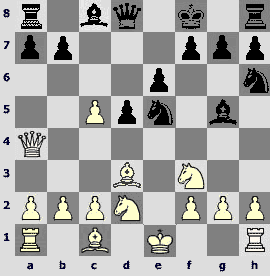
13...¤xd3+
13...¤xf3+ 14.¤xf3 Ґxc1 15.¦xc1 e5 16.¤xe5!? (the quiet 16.¦d1 is also possible) 16...Јg5 17.f4 Јxg2 18.¦f1 Јxh2 19.c6 with a highly perplexed position.
14.cxd3 Ґe7 15.b4 f6 16.0–0 ¤f5 17.Ґb2 h5 18.¦ac1 Ґd7 19.Јb3 ¦c8 20.¤d4 ¤xd4 21.Ґxd4 h4 22.h3 Јe8 23.f4 Јg6 24.ўh1 ¦h5 25.¤f3 a6 26.¦ce1 Ґd8 27.Ґg1 ўg8 28.¤d4 Јf7 29.Јd1 g6 30.Ґh2 Ґc7
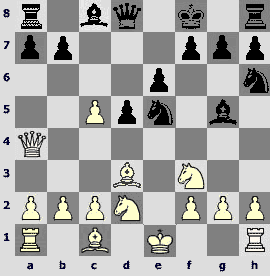
31.f5! exf5 32.Ґxc7 ¦xc7 33.¦e3 ¦h8 34.¦fe1 Ґc8 35.Јf3 ўh7 36.b5 Јf8 37.b6 ¦g7 38.Јxd5 Јd8 39.Јc4 g5 40.¤e6 Ґxe6 41.¦xe6 ¦f8 42.¦d6 Јb8 43.Јd5 ўg6 44.¦f1 Јc8 45.¦e6 f4 46.Јe4+ ўh6 47.d4 ¦d7 48.¦e1 ўg7 49.a3 Јd8 50.d5 ¦df7 51.d6 Јc8 52.Јd5 f3 53.gxf3 Јd7 54.ўg2 Јa4 55.¦e7 Јf4 56.ўf1 Јh2 57.Јf5 Јh1+ 58.ўf2 Јh2+ 59.ўf1 Јh1+ 60.ўe2 Јh2+ 61.ўd1 Јb2 62.¦1e3 Јd4+ 63.ўe2 Јb2+ 64.ўf1 Јc1+ 65.ўg2 Јd2+ 66.¦e2 Јd1 67.Јc2 Јd4 68.d7 g4 69.Јe4 gxf3+ 70.Јxf3 f5 71.Јxf5 ўh8 72.Јh5+ ўg7 73.¦xf7+ 1–0
Round8
I.Khairullin (2543) – P.Svidler (2750) [B46]
Obtaining a very dubious position after the opening Peter Svidler made a draw offer which was accepted.
1.e4 c5 2.¤f3 e6 3.d4 cxd4 4.¤xd4 ¤c6 5.¤c3 a6 6.¤xc6 bxc6 7.Ґd3 d5 8.0–0 ¤f6 9.¦e1 Ґe7 10.e5 ¤d7 11.Јg4 g6 12.¤a4 Јa5 13.Ґh6 c5 14.b3 c4 15.Ґf1 Ґb7 16.¦e3 Ґc6 17.Јf4 Јc7 18.¤b2 Ґc5 19.¦e2 ¦b8 20.¤d1 Јa5 Ѕ–Ѕ
E.Alekseev (2639) – E.Inarkiev (2628) [C54]
1.e4 e5 2.¤f3 ¤c6 3.Ґc4 ¤f6 4.d3 Ґc5 5.c3 a6 6.Ґb3 0–0 7.0–0 Ґa7 8.Ґe3 d5 9.exd5 ¤xd5 10.Ґxa7 ¦xa7 11.d4 e4 Ѕ–Ѕ
S.Rublevsky (2688) – N.Vitiugov (2596) [C07]
1.e4 e6 2.d4 d5 3.¤d2 c5 4.¤gf3 cxd4 5.exd5 Јxd5 6.Ґc4 Јd6 7.0–0 ¤f6 8.¤b3 ¤c6 9.¤bxd4 ¤xd4 10.¤xd4 a6 11.Ґb3 Ґd7 12.c3 Јc7 13.Ґg5 0–0–0 14.Ґxf6 gxf6 15.Јh5 Ґe8 16.¦ad1 ўb8 17.¦fe1 ¦c8 18.Јh4 Ґe7
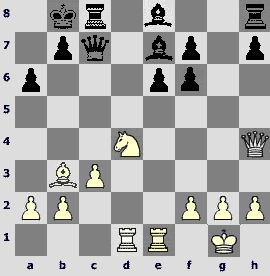
19.g3? This move creates an object for the attack of the black h-pawn. It was better to stop this pawn by 19.Јh6.
19...h5 20.Јf4. More or less forced. White is already clearly worse. 20...Јxf4 21.gxf4 ¦g8+ 22.ўf1 f5 23.¦e3 Ґc5 24.ўe2 ¦g4 25.ўf3
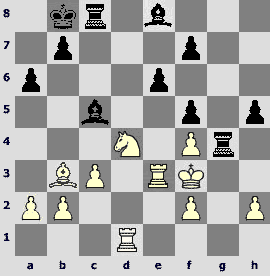
25...Ґb6. The delay which allowed White to save himself. After the simple and natural 25...Ґd7 the defence against ¦dg8 is nowhere to be seen. 26.h3 fails to 26...¦h4 27.ўg3 ¦g8, and the rook is untouchable in view of checkmate.
26.h3 ¦g8 27.¦ee1 h4 28.¦g1 Ґxd4 29.cxd4 Ґc6+ 30.ўe3 a5 31.¦g5 a4 32.Ґc4 Ґe4 33.Ґd3 Ґxd3 Ѕ–Ѕ
I.Nepomniachtchi (2545) – D.Khismatullin (2583) [B23]
1.e4 c5 2.¤c3 d6 3.f4 ¤c6 4.¤f3 g6 5.Ґc4 Ґg7 6.0–0 e6 7.f5 ¤f6. It seems to me that Black wasn`t ready for this rare line. My friendly advice to Denis – when you don`t know what to do grab the material! I believe more promising is 7...exf5 followed by 8...¤ge7 but there`s a lot of theory there.
8.d3 0–0 9.fxg6 fxg6
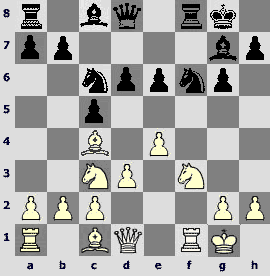
10.e5! dxe5 11.Ґg5 h6 12.Ґxf6 ¦xf6 13.¤e4 ¦f8 14.a3 Јe7 15.c3 a6 16.Јe1 a5 17.Јg3 ўh7
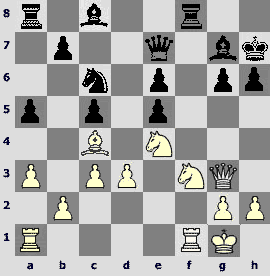
18.¤fg5+? Very creative! Albeit I don`t want to I`m forced to attach the question mark. But I should say – well done Ian! Fortune favours the brave! Objectively White is strategically winning. Strong was 18.¤h4 g5 19.¦xf8 (if 19.¤f3, then the black rook occupies a powerful position after 19...¦f4!) 19...Јxf8 20.¤f3 Јf4 21.Јe1, with a decisive advantage. Now a new game begins with irregular material ratio where I would estimate Black`s chances as more preferable. The following play has confirmed this evaluation: Denis has coordinated his pieces obtaining an edge but before time control (probably in time scramble) made a mistake and lost.
18...hxg5 19.¦xf8 Ґxf8 20.¤xg5+ ўg8 21.¦f1 Ґh6 22.¤e4 ўg7 23.¦f6 Јxf6 24.¤xf6 ўxf6 25.Јf2+ ўg7 26.Јxc5 Ґd7 27.ўf2 ¦f8+ 28.ўe1 ¦f7 29.b4 axb4 30.axb4 Ґg5 31.b5 Ґe7 32.Јb6 ¤d8 33.ўe2 Ґf6 34.g3 g5 35.Ґb3 Ґe8 36.g4 ¦d7 37.Ґc4 Ґg6 38.Јc5 ¦e7 39.Јc8 ¦e8 40.Јc7+ Ґf7 41.ўf2 ¦h8 42.ўg2 ўh6 43.Јd6 Ґg6 44.b6 Ґe8 45.Ґd5 Ґg6 46.Ґf3 ¦g8 47.c4 Ґe8 48.c5 ўh7 49.ўh3 ўh8 50.Ґe4 Ґc6 51.Ґxc6 bxc6 52.ўg2 ўh7 53.b7 ¤xb7 54.Јxe6 Ґd8 55.Јxc6 ¦g7 56.Јe4+ ўg8 57.Јd5+ 1–0
S.Grigoriants (2582) – E.Tomashevsky (2595) [C84]
1.e4 e5 2.¤f3 ¤c6 3.Ґb5 a6 4.Ґa4 ¤f6 5.0–0 b5 6.Ґb3 Ґb7 7.d3 Ґe7 8.¤bd2 0–0 9.¦e1 ¦e8 10.¤f1 Ґf8 11.Ґd2 h6 12.¤g3 d6 13.a4 Јd7 14.Ґa2 ¦ad8 15.¤h4 d5 16.exd5 ¤xd5 17.¤e4 ¤f4 18.axb5 axb5
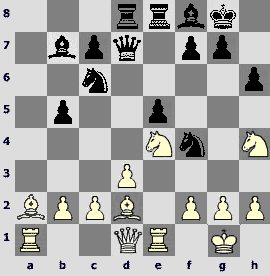
19.¤f3?! This looks strange. Who wants to tolerate such a knight on f4? Consistent is 19.Ґxf4 exf4, and now White may choose between 20.Јh5 and 20.¤g6 with roughly equal chances in both cases.
19...¤b4 20.Ґb3 ¤bd5 21.¦a7 Ґc6
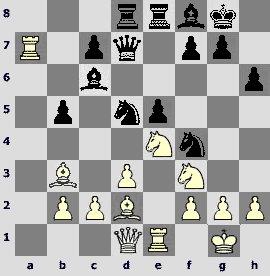
22.g3?! Now Black firmly takes the initiative. The weakened diagonal should tell at some point.
22...¤h3+ 23.ўg2 ўh8 24.¦a6 f5 25.¤c3 ¤xc3 26.bxc3 Ґb7 27.ўxh3 Ґxa6 28.¤xe5 ¦xe5 29.¦xe5 Ґb7 30.f3 Ґd6 31.Ґe6 Јe7 32.¦e1 Јf6 33.ўg2 f4 34.g4 g6 35.c4 bxc4 36.Ґxc4 h5 37.gxh5 Јg5+ 38.ўh1 Јxh5 39.¦f1 ¦e8 40.d4 ўh7 41.Ґd3 c5 42.dxc5 Ґxc5 43.Ґe2 Јe5 44.Ґd3 Јd5 45.ўg2 Јg5+ 46.ўh1 Јg4 47.Ґa6 Ґa8 48.Ґd3 ¦e5 49.Ґxg6+ ўxg6 50.Ґc3 ¦g5 51.Јd3+ ўh6 0–1
E.Najer (2648) – D.Jakovenko (2671) [E20]
1.d4 ¤f6 2.c4 e6 3.¤c3 Ґb4 4.g3 c5 5.¤f3 cxd4 6.¤xd4 0–0 7.Ґg2 d5 8.cxd5 ¤xd5 9.Јb3 Јa5 10.Ґd2 ¤c6 11.¤xc6 bxc6 12.0–0 Ґxc3 13.bxc3 Ґa6 14.¦fd1 Јc5 15.e4 Ґc4 16.Јa4 ¤b6 17.Јb4 Јh5 18.Ґf4

18...e5. Black`s last move is a novelty, an attempt to improve upon the game Bacrot – Grischuk Poikovsky 2005, which went 18...c5 19.Јb2 e5 20.Ґe3 ¦fc8 21.f3 Јg6 22.a4, and the advantage is on White`s side.
19.Ґe3 Ґe2. The с4 square is freed for the knight with a tempo.
20.¦e1 ¤c4 21.Јc5 ¦fd8 22.¦ab1. 22.f3 ¤xe3 23.Јxe3 Ґc4 24.Јc5 Ґe6 isn`t dangerous as the black queen will enter the game later on via the c1-h6 diagonal while the d-file is already occupied by Black and he keeps an eye on the a2 pawn. As a result Black has no problems.
22...h6. The escape for the king is always of use.
23.h3 ¤xe3 24.Јxe3 Ґc4 25.a4 a5 26.Јc5 Ґe6 27.h4. 27.Јxc6 Ґxh3 leads to equality.
27...¦d2 28.Јxc6 ¦c8 29.Јb5 ¦xc3 30.Јxa5 ¦cc2. Black has a piece activity for the sacrificed pawn.
31.Јa7 ¦a2 32.¦a1. To push the pawn forward first 32.a5 looked more logical but Black has a useful move 32...ўh7!, taking the king away from possible checks. The continuation could be for example 33.¦a1 Јe2! 34.Ґf1 Јf3 35.Јe3 Јxe3 36.fxe3 Ґg4!, and thanks to the idea of bishop`s intrusion to f3 Black holds.
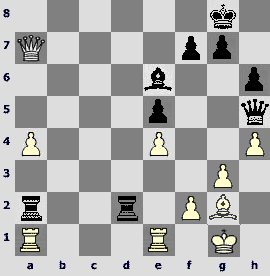
32...Јe2! A nice move that leads to clear equality.
33.¦xe2?! Mathematically, from the computer standpoint this move is not a mistake but to play with the queen is more difficult. White should search for perpetual while Black with his coordinated rooks has nothing to worry about at all. A draw could be achieved in different ways: 33.¦f1 ўh7 34.a5 Јb5 threatening with Јa4, after which the lonely a5 pawn will perish; or 33.Ґf1 ¦xa1 (after 33...Јf3 34.¦xa2 ¦xa2 35.Јc5 Black`s problems will remain) 34.¦xa1 Јxe4 35.Ґg2 Јb4 36.a5 Јc3 37.¦b1 ¦a2.
33...¦xa1+ 34.ўh2 ¦xe2 35.a5. The most precise was 35.Ґh3! immediately provoking the weakening of the light squares in Black`s camp. In this case perpetual will be unavoidable.
35...ўh7. Stronger is 35...¦aa2! 36.ўg1 ўh7, preventing the bishop exchange via h3.
36.Ґh3! After a one move lag White applies the saving idea.
36...¦aa2 37.Ґxe6 ¦xf2+ 38.ўh3 fxe6 39.ўg4? The self suggesting 39.h5! allowed to force the draw.
39...¦ae2 40.a6 ¦xe4+ 41.ўh3 ¦ee2 42.h5. Once again the correct idea is carried out with a lag.
42...¦f5
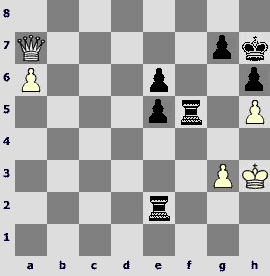
43.Јb8? In this position it is already easy to err. A draw was achieved in the unique way: 43.Јb7 ¦xh5+ 44.ўg4 ¦f5 45.ўh3! ¦ff2 46.Јb1+! ўg8 47.a7 ¦a2 48.Јb8+ ¦f8 49.Јb6.
43...¦xh5+ 44.ўg4 ¦e4+ 45.ўf3 ¦a4. White loses his only trump – the passed pawn.
46.Јb6 e4+ 47.ўe3 ¦ha5 48.Јxe6 ¦xa6 49.Јf5+ ¦g6 50.g4 ¦a3+ 0–1
